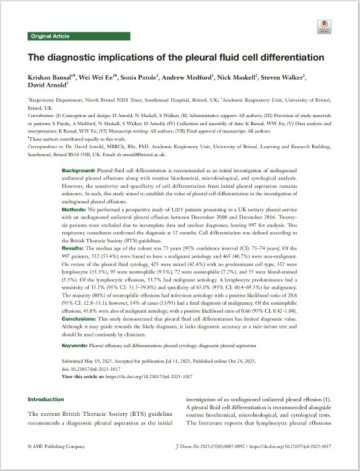Pleural fluid cell differentiation does not accurately diagnose the cause of fluid around the lungs
- 19 November 2025
Using pleural fluid cell differentiation as a test to determine the reason for fluid building up around the lungs does not provide an accurate diagnosis, according to a new study. Findings from the study, performed by a team including BRC researchers, are published in the Journal of Thoracic Disease.
Pleural effusion – a build-up of fluid around the lungs – can be caused by lung cancer, heart failure or an infection, among many other things.
Pleural fluid cell differentiation is one of the tests recommended for patients who come to hospital with fluid around their lungs, to find out the cause. This test is time-consuming and there is not much evidence that it works.
Researchers studied 997 patients attending a specialist lung clinic with an undiagnosed pleural effusion in one lung, between December 2008 and December 2016. They compared the results of pleural fluid cell differentiation with a confirmed diagnosis by two respiratory consultants a year later.
The study found that pleural fluid cell differentiation could not be used to give a definitive diagnosis, or to rule out any specific cause. This is one of the largest studies to investigate the ability of this test to diagnose the cause of pleural effusions.
Based on these results, the researchers advise healthcare professionals not to rely on pleural fluid cell differentiation to diagnose the cause of a fluid around the lungs. They also recommend further research to find out whether the test should be used at all.
Dr David Arnold, NIHR Consultant Senior Lecturer in Respiratory Medicine at the University of Bristol and a member of the study team, said:
“Pleural effusions which form around one lung can be caused by many serious underlying diseases. Pleural fluid cell differentiation is recommended by national guidelines to investigate these.
“However, our research shows that this test is poorly associated with the true cause of the disease. Therefore, we recommend that physicians should use it cautiously in this setting, to prevent missing important diagnoses.”
